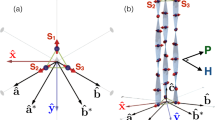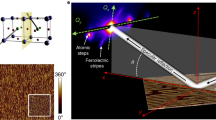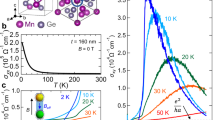Abstract
Non-coplanar spin textures with scalar spin chirality can generate an effective magnetic field that deflects the motion of charge carriers, resulting in a topological Hall effect (THE)1,2,3. However, spin chirality fluctuations in two-dimensional ferromagnets with perpendicular magnetic anisotropy have not been considered so far. Here, we report evidence of spin chirality fluctuations by probing the THE above the Curie temperature in two different ferromagnetic ultra-thin films, SrRuO3 and V-doped Sb2Te3. The temperature, magnetic field, thickness and carrier-type dependence of the THE signal, along with Monte Carlo simulations, suggest that spin chirality fluctuations are a common phenomenon in two-dimensional ferromagnets with perpendicular magnetic anisotropy. Our results open a path for exploring spin chirality with topological Hall transport in two-dimensional magnets and beyond4,5,6,7.
This is a preview of subscription content, access via your institution
Access options
Access Nature and 54 other Nature Portfolio journals
Get Nature+, our best-value online-access subscription
$29.99 / 30 days
cancel any time
Subscribe to this journal
Receive 12 print issues and online access
$259.00 per year
only $21.58 per issue
Buy this article
- Purchase on Springer Link
- Instant access to full article PDF
Prices may be subject to local taxes which are calculated during checkout




Similar content being viewed by others
Data availability
The data that support the findings of this study are available from the corresponding author upon reasonable request.
Code availability
The code for the MC simulations is available from M.W.D. and D.X. on reasonable request.
References
Wen, X. G., Wilczek, F. & Zee, A. Chiral spin states and superconductivity. Phys. Rev. B 39, 11413–11423 (1989).
Taguchi, Y., Oohara, Y., Yoshizawa, H., Nagaosa, N. & Tokura, Y. Spin chirality, Berry phase, and anomalous Hall effect in a frustrated ferromagnet. Science 291, 2573–2576 (2001).
Neubauer, A. et al. Topological Hall effect in the A phase of MnSi. Phys. Rev. Lett. 102, 186602 (2009).
Bonilla, M. et al. Strong room-temperature ferromagnetism in VSe2 monolayers on van der Waals substrates. Nat. Nanotechnol. 13, 289–293 (2018).
Fei, Z. et al. Two-dimensional itinerant ferromagnetism in atomically thin Fe3GeTe2. Nat. Mater. 17, 778–782 (2018).
Deng, Y. J. et al. Gate-tunable room-temperature ferromagnetism in two-dimensional Fe3GeTe2. Nature 563, 94–99 (2018).
Machida, Y., Nakatsuji, S., Onoda, S., Tayama, T. & Sakakibara, T. Time-reversal symmetry breaking and spontaneous Hall effect without magnetic dipole order. Nature 463, 210–213 (2010).
Nagaosa, N., Sinova, J., Onoda, S., MacDonald, A. H. & Ong, N. P. Anomalous Hall effect. Rev. Mod. Phys. 82, 1539–1592 (2010).
Zang, J., Mostovoy, M., Han, J. H. & Nagaosa, N. Dynamics of Skyrmion crystals in metallic thin films. Phys. Rev. Lett. 107, 136804 (2011).
Kanazawa, N. et al. Large topological hall effect in a short-period helimagnet MnGe. Phys. Rev. Lett. 106, 156603 (2011).
Huang, S. X. & Chien, C. L. Extended skyrmion phase in epitaxial FeGe(111) thin films. Phys. Rev. Lett. 108, 267201 (2012).
Matl, P. et al. Hall effect of the colossal magnetoresistance manganite La1−xCaxMnO3. Phys. Rev. B 57, 10248–10251 (1998).
Ye, J. W. et al. Berry phase theory of the anomalous Hall effect: application to colossal magnetoresistance manganites. Phys. Rev. Lett. 83, 3737–3740 (1999).
Chun, S. H., Salamon, M. B., Lyanda-Geller, Y., Goldbart, P. M. & Han, P. D. Magnetotransport in manganites and the role of quantal phases: theory and experiment. Phys. Rev. Lett. 84, 757–760 (2000).
Koster, G. et al. Structure, physical properties, and applications of SrRuO3 thin films. Rev. Mod. Phys. 84, 253–298 (2012).
Chang, C.-Z. et al. High-precision realization of robust quantum anomalous Hall state in a hard ferromagnetic topological insulator. Nat. Mater. 14, 473–477 (2015).
Thomas, S. et al. Localized control of Curie temperature in perovskite oxide film by capping-layer-induced octahedral distortion. Phys. Rev. Lett. 119, 177203 (2017).
Klein, L. et al. Transport and magnetization in the badly metallic itinerant ferromagnet SrRuO3. J. Phys. Condens. Matter 8, 10111–10126 (1996).
Yasuda, K. et al. Geometric Hall effects in topological insulator heterostructures. Nat. Phys. 12, 555–559 (2016).
Matsuno, J. et al. Interface-driven topological Hall effect in SrRuO3-SrIrO3 bilayer. Science Adv. 2, e1600304 (2016).
Liu, C. et al. Dimensional crossover-induced topological Hall effect in a magnetic topological insulator. Phys. Rev. Lett. 119, 176809 (2017).
Fang, Z. et al. The anomalous Hall effect and magnetic monopoles in momentum space. Science 302, 92–96 (2003).
Hou, W.-T., Yu, J.-X., Daly, M. & Zang, J. Thermal driven topology in chiral magnets. Phys. Rev. B 96, 140403(R) (2017).
Böttcher, M., Heinze, S., Egorov, S., Sinova, J. & Dupe, B. B-T phase diagram of Pd/Fe/Ir(111) computed with parallel tempering Monte Carlo. New J. Phys. 20, 103014 (2018).
Hellwig, O., Berger, A., Kortright, J. B. & Fullerton, E. E. Domain structure and magnetization reversal of antiferromagnetically coupled perpendicular anisotropy films. J. Mag. Mag. Mater. 319, 13–55 (2007).
Dzyaloshinsky, I. A thermodynamic theory of ‘weak’ ferromagnetism of antiferromagnetics. J. Phys. Chem. Solids 4, 241–255 (1958).
Moriya, T. Anisotropic superexchange interaction and weak ferromagnetism. Phys. Rev. 120, 91–98 (1960).
Rohart, S. & Thiaville, A. Skyrmion confinement in ultrathin film nanostructures in the presence of Dzyaloshinskii–Moriya interaction. Phys. Rev. B 88, 184422 (2013).
Hyun, S. & Char, K. Effects of strain on the dielectric properties of tunable dielectric SrTiO3 thin films. Appl. Phys. Lett. 79, 254 (2001).
Berg, B. & Luescher, M. Definition and statistical distributions of a topological number in the lattice O(3) σ-model. Nucl. Phys. B 190, 412–424 (1981).
Acknowledgements
We are grateful to R. Swendsen for many useful discussions on MC simulations. The work at Rutgers was supported by the Office of Basic Energy Sciences, Division of Materials Sciences and Engineering, US Department of Energy under award no. DE-SC0018153. The work at CMU was supported by the Office of Basic Energy Sciences, Division of Materials Sciences and Engineering, US Department of Energy under award no. DE-SC0012509. The work at UMD was supported under the Cooperative Research Agreement between the University of Maryland and the National Institute of Standards and Technology Center for Nanoscale Science and Technology, award no. 70NANB14H209, through the University of Maryland. The work at U. Twente was supported by Nederlandse Organisatie voor Wetenschappelijk Onderzoek through grant no. 13HTSM01. The work at Penn State was supported by ARO Young Investigator Program award no. W911NF1810198. C.-Z.C. acknowledges support of an Alfred P. Sloan Research Fellowship.
Author information
Authors and Affiliations
Contributions
W.Wu conceived and supervised the project. Z.L., J.W., G.K. and G.R. synthesized the SRO samples and performed X-ray diffraction. Y.Z. and C.-Z.C. synthesized the VST samples. W.Wang performed the magnetotransport experiments and analysed the data. M.W.D. and D.X. performed the MC simulations. W.Wang, W.Wu, M.W.D. and D.X. wrote the manuscript. All authors discussed the data and contributed to the manuscript.
Corresponding author
Ethics declarations
Competing interests
The authors declare no competing interests.
Additional information
Publisher’s note: Springer Nature remains neutral with regard to jurisdictional claims in published maps and institutional affiliations.
Supplementary information
Supplementary Information
Supplementary Figs. 1–22, Supplementary Notes A–O and supplementary refs. 1–11.
Rights and permissions
About this article
Cite this article
Wang, W., Daniels, M.W., Liao, Z. et al. Spin chirality fluctuation in two-dimensional ferromagnets with perpendicular magnetic anisotropy. Nat. Mater. 18, 1054–1059 (2019). https://doi.org/10.1038/s41563-019-0454-9
Received:
Accepted:
Published:
Issue Date:
DOI: https://doi.org/10.1038/s41563-019-0454-9
This article is cited by
-
Magnetism and berry phase manipulation in an emergent structure of perovskite ruthenate by (111) strain engineering
npj Quantum Materials (2023)
-
Pressure-tuning domain-wall chirality in noncentrosymmetric magnetic Weyl semimetal CeAlGe
Science China Physics, Mechanics & Astronomy (2023)
-
Visualization of ferromagnetic domains in vanadium-doped topological insulator thin films and heterostructures
Tungsten (2023)
-
Challenges in identifying chiral spin textures via the topological Hall effect
Communications Materials (2022)
-
Emergent ferromagnetism and insulator-metal transition in δ-doped ultrathin ruthenates
npj Quantum Materials (2022)



